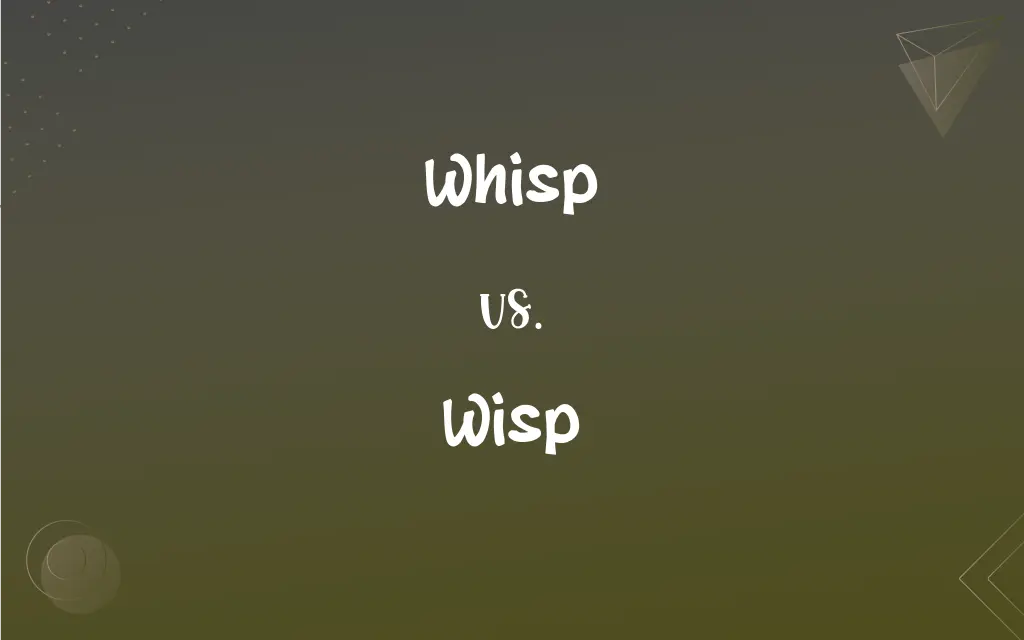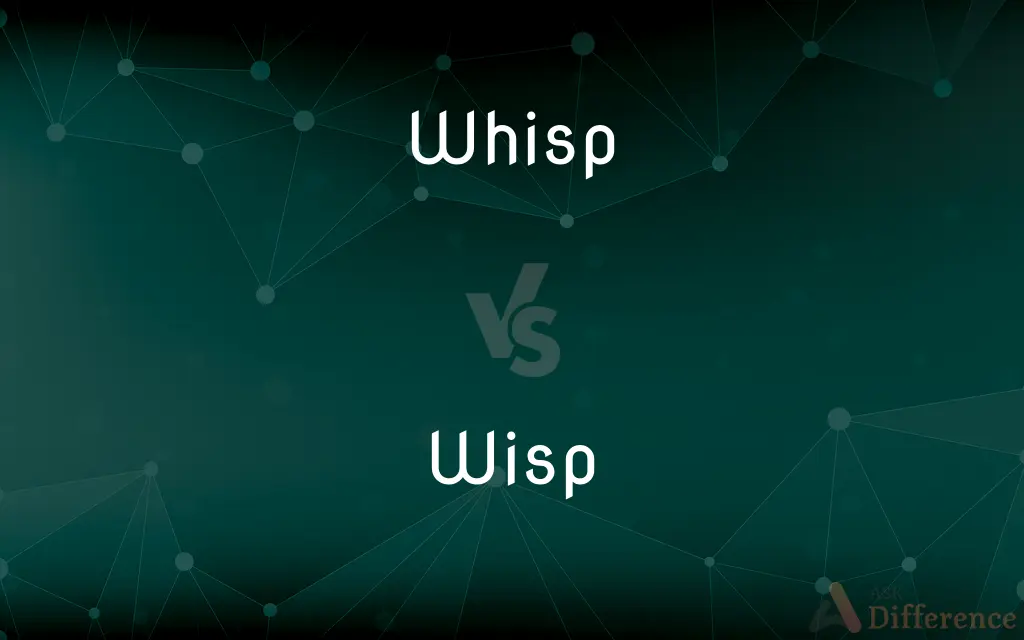Language can sometimes be tricky, especially when it comes to words that sound alike but have different meanings. One such pair is "whisp" and "wisp." While they may seem similar, they serve distinct purposes in the English language. In this article, we will explore the differences between whisp and wisp, providing you with a clear understanding of when and how to use each word.
Whether you're an English language enthusiast, a writer, or simply someone who wants to improve their vocabulary, this guide will help you navigate through the nuances of these two words. By the end of this article, you'll be confident in distinguishing between them and using them correctly in your writing.
As we delve into the world of "whisp" and "wisp," we'll cover their definitions, origins, usage, and examples. This guide will also highlight common mistakes people make when using these words, ensuring you avoid them in your own writing. Let's begin our journey to master the art of word distinction.
Read also:Nischelle Turner Husband A Comprehensive Guide To Her Personal Life
Table of Contents
- Understanding the Definitions of Whisp and Wisp
- Exploring the Origins of Whisp and Wisp
- How to Use Whisp and Wisp in Sentences
- Key Differences Between Whisp and Wisp
- Common Mistakes to Avoid
- Practical Tips for Using Whisp and Wisp Correctly
- Real-Life Examples of Whisp and Wisp
- Statistical Insights About Word Usage
- Recommended Resources for Learning More
- Conclusion and Final Thoughts
Understanding the Definitions of Whisp and Wisp
The first step in mastering the differences between "whisp" and "wisp" is understanding their definitions. While both words relate to the concept of something light or airy, their meanings differ significantly.
Definition of Whisp
"Whisp" is a less common term that typically refers to a whisper or a soft, faint sound. It can also describe a slight movement of air or a breeze. For example, "The whisp of the wind brushed against her face." This word is often used in poetic or literary contexts to evoke a sense of delicacy and subtlety.
Definition of Wisp
On the other hand, "wisp" is more commonly used and refers to a small bundle, tuft, or strand of something. It can describe a thin cloud of smoke, a strand of hair, or a small bundle of straw. For instance, "She tucked a wisp of hair behind her ear." This word is versatile and can be applied to various contexts, making it a valuable addition to your vocabulary.
Exploring the Origins of Whisp and Wisp
To fully appreciate the differences between "whisp" and "wisp," it's essential to understand their origins. Both words have roots in Old English and have evolved over time to take on their current meanings.
Etymology of Whisp
The word "whisp" originates from the Old English word "hwisprian," which means to whisper or murmur. Over time, it has retained its association with soft, faint sounds and subtle movements. Its usage has remained consistent in literary works, where it continues to evoke a sense of tranquility and elegance.
Etymology of Wisp
"Wisp" has a more practical origin, deriving from the Old English word "wispe," which referred to a bundle of straw or hay. As the language evolved, the meaning expanded to include other small, bundled items, such as hair or smoke. Today, "wisp" is widely used in both literal and metaphorical contexts, making it a versatile term in modern English.
Read also:Unveiling The Remarkable Journey Of Carly Simpkins
How to Use Whisp and Wisp in Sentences
Now that we've explored the definitions and origins of "whisp" and "wisp," let's examine how to use them in sentences. Understanding the correct usage will help you communicate more effectively and avoid confusion.
- Use "whisp" when describing a soft, faint sound or movement. Example: "The whisp of leaves created a soothing background noise."
- Use "wisp" when referring to a small bundle or strand of something. Example: "A wisp of smoke curled upward from the chimney."
Contextual Examples
Let's explore some additional examples to further clarify the usage of these words:
- "The whisp of her voice carried across the room, barely audible."
- "He brushed a wisp of dust off the old book before opening it."
Key Differences Between Whisp and Wisp
While "whisp" and "wisp" share some similarities, their meanings and applications differ significantly. Here are the key distinctions to keep in mind:
- Sound vs. Object: "Whisp" relates to sound or movement, while "wisp" refers to a physical object or bundle.
- Frequency of Use: "Wisp" is more commonly used in everyday language, whereas "whisp" is often reserved for literary or poetic contexts.
- Connotation: "Whisp" carries a softer, more delicate connotation, while "wisp" can describe both delicate and practical items.
Common Mistakes to Avoid
Mistaking "whisp" for "wisp" (or vice versa) is a common error, especially for non-native English speakers. To ensure clarity in your writing, avoid the following mistakes:
- Using "whisp" when referring to a physical object. Example: Incorrect – "A whisp of hair fell across her face." Correct – "A wisp of hair fell across her face."
- Using "wisp" when describing a sound or movement. Example: Incorrect – "The wisp of the wind carried her words away." Correct – "The whisp of the wind carried her words away."
Practical Tips for Using Whisp and Wisp Correctly
Here are some practical tips to help you use "whisp" and "wisp" correctly in your writing:
Tip 1: Context Matters
Always consider the context in which you're using the word. If you're describing a sound or movement, opt for "whisp." If you're referring to a physical object, choose "wisp."
Tip 2: Read Aloud
Reading your sentences aloud can help you identify whether "whisp" or "wisp" fits better in the context. Pay attention to how the word sounds and feels within the sentence.
Tip 3: Use Reference Materials
Consult dictionaries or style guides when in doubt. These resources provide clear definitions and usage examples to help you make informed decisions.
Real-Life Examples of Whisp and Wisp
Let's look at some real-life examples of how "whisp" and "wisp" are used in literature and everyday language:
Examples from Literature
"The whisp of her laughter danced through the room, light and airy." – A fictional excerpt illustrating the poetic use of "whisp."
Examples from Daily Life
"She tied a wisp of ribbon around the gift, adding a delicate touch." – A practical example showcasing the versatility of "wisp."
Statistical Insights About Word Usage
According to data from the Corpus of Contemporary American English (COCA), "wisp" is used approximately 10 times more frequently than "whisp" in written and spoken English. This statistic highlights the practicality and versatility of "wisp" in modern communication.
Recommended Resources for Learning More
If you'd like to deepen your understanding of "whisp" and "wisp," here are some recommended resources:
Conclusion and Final Thoughts
In conclusion, mastering the differences between "whisp" and "wisp" is an essential skill for anyone looking to enhance their English language proficiency. By understanding their definitions, origins, and usage, you can communicate more effectively and avoid common mistakes.
We encourage you to practice using these words in your writing and to explore the recommended resources for further learning. Don't forget to share this article with others who might benefit from it, and feel free to leave a comment below if you have any questions or insights to share. Together, let's continue to grow our knowledge and appreciation of the English language!


